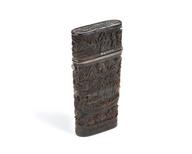


Antimony cup, probably 16th or 17th century
Cups made from antimony, a toxic, metallic element, became popular in the 1600s as a means of purging the body of illness through the sweating and vomiting this poison caused. Wine would be allowed to stand in the cup for up to 24 hours, by which time a small amount of the metal had dissolved.
It has been suggested that the cups were introduced in order to get around the law at a time when the sale and use of antimony preparations was strictly forbidden. When making such a preparation, three tablespoons of antimony could cause the desired effects, although it would have been a highly unpleasant experience.
Details
- Category:
- Therapeutics
- Collection:
- Sir Henry Wellcome's Museum Collection
- Object Number:
- A641035
- Materials:
- antimony
- Measurements:
-
overall: 110 mm 83 mm, .51kg
- type:
- antimony cup




